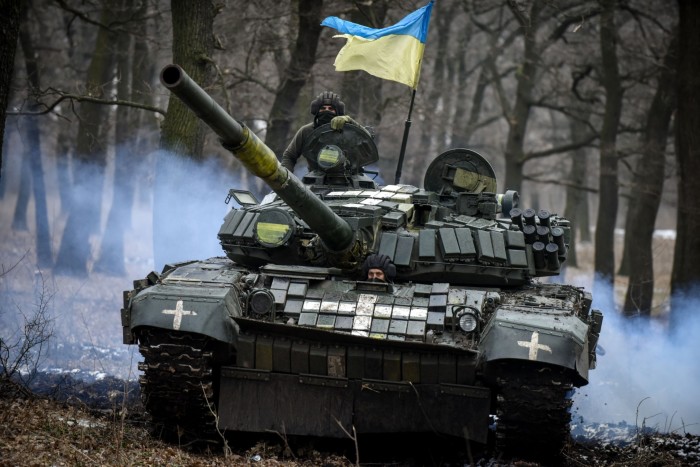[ad_1]
Defence officials from 50 countries are meeting in Ramstein, Germany, on Friday to agree on more military aid for Ukraine. At the top of the list for discussion is whether they should send modern western-designed heavy battle tanks, an item until recently considered taboo for Kyiv’s allies.
Such tanks are deemed essential for Ukraine’s efforts to retake territory from Russia, which has mobilised 150,000 troops for a renewed offensive. Moscow has also put the country’s defence industry on to a war footing in order to refit and rearm its forces. The next six months are critical, for both sides.
Why are some countries ready to send modern battle tanks?
In short, to help Ukraine break the deadlock on the battlefield and retake its territory from Russian occupying forces.
Western tanks — such as the US M1 Abrams, Britain’s Challenger 2 or the German-built Leopard 2 — would give the Ukrainian army additional firepower to smash through Russian defensive lines and seize the military initiative before Moscow can. They would also be needed to defend Ukrainian lines against a possible renewed Russian offensive later this year.
Tanks are a crucial element in so-called combined arms manoeuvre — mobile operations involving infantry and artillery — to take territory. Moreover, western tanks would give Ukraine an advantage over Russian ones because they have superior armour, more accurate cannon and better control and navigation systems — enabling night-time operations, for example.
Why is the Leopard 2 tank on top of Kyiv’s wishlist?
Germany’s Leopard has similar capabilities to the US-made Abrams or UK’s Challenger, but also presents some advantages, according to military experts. It is lighter and easier to fuel than the American tank, which is powered by a thirsty turbine engine. It is deemed more reliable than the Challenger.
But the crucial advantage is its availability. There are 13 European armies in Europe operating some 2,000 Leopard 2 tanks, according to the International Institute for Strategic Studies. It is unclear how many of these are battle-ready and how many would require refurbishment. But it is a large pool for Ukraine to draw on. There are also multiple sources of spare parts and maintenance experts.
Does Ukraine have tanks already?
Yes, lots. It had its own fleet of Soviet-era tanks. It has captured more than 500 tanks from Russian forces since their full-scale invasion last February. It has also been supplied with 240 T-72s from Poland and the Czech Republic. But it is losing a lot of tanks to enemy fire — possibly as many as 130 a month, according to Gustav Gressel of the European Council on Foreign Relations.

There are also only a few sources of ammunition and spare parts for Soviet-era tanks among Ukraine’s allies. So, as with artillery, Ukraine needs to shift to western-standard equipment or risk running out of shells, replacement barrels and other spare parts.
That is another advantage of the Leopard 2: if its potentially large stock is made available, that would simplify logistical support for the Ukrainian forces as repairs, spare parts and ammunition would be the same.
Nato allies have sent armoured vehicles. Why the hesitation on tanks?
Multiple governments, including the US, Germany, Britain, France and Sweden have pledged infantry fighting vehicles and other combat armoured vehicles to Ukraine.
The US has said it will donate at least 50 Bradleys and 100 Strykers, while Germany is providing Marders. These armoured personnel vehicles also have powerful guns, which will give Ukraine an additional offensive capability.
France this month said it would send an unspecified number of AMX-10 “tank killer” armoured vehicles, which are regarded by some analysts as light tanks.
However, western main battle tanks, with their chain tracks and sophisticated fire control systems and heavy guns, provide a level of firepower that western allies have so far been reluctant to grant Kyiv.
The UK sought to break that mental barrier last week when it said it would send 14 Challenger tanks to Ukraine. The numbers are not militarily significant, but the decision set a precedent that Britain hoped would encourage other countries to do the same, soon.
However, the US has said it will not send its Abrams tanks, because they are too hard for Ukraine to maintain and other suitable options in the region abound, namely the Leopard. The German government has balked at sending its Leopards given the risk that Russia would see the move as an escalation that could drag Nato into the conflict.
Why is Germany’s role so pivotal?
Under the terms of its export contracts, Berlin’s approval is required if other governments want to donate Leopard tanks to Kyiv.
Germany has about 350 of its own Leopard 2s, although it is unclear how many of them are fully operational. Boris Pistorius, Germany’s new defence minister, said on Friday the military would begin technical assessments of the tank fleet’s readiness for combat pending a final decision on whether to send them.
Chancellor Olaf Scholz is worried that, since Leopard tank supplies to Kyiv in effect hinge on his backing, any green light would be regarded by Moscow as a German-led escalation. That is why Scholz wants the US to agree to send tanks before he gives his approval.
[ad_2]
Source link